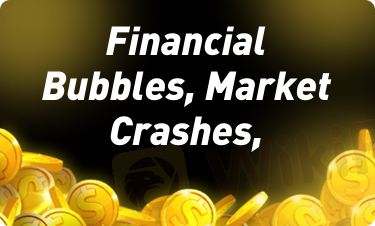
2025-02-17 18:19
업계에서Financial Market Bubbles and Crashes
#firstdealofthenewyearastylz
Financial Market Bubbles and Crashes
A financial market bubble occurs when asset prices rise significantly above their intrinsic value due to excessive speculation, investor overconfidence, and herd behavior. Eventually, when the overvaluation is no longer sustainable, the bubble bursts, leading to a market crash—a rapid and often severe decline in asset prices.
Causes of Financial Bubbles
1. Excess Liquidity – Low interest rates and easy access to credit can inflate asset prices.
2. Speculation & Herd Mentality – Investors buy assets purely based on rising prices, not fundamentals.
3. Overconfidence & Irrational Exuberance – Investors ignore risks and believe prices will keep rising.
4. Leverage & Margin Trading – Borrowing money to invest amplifies gains but also magnifies losses.
5. Technological or Economic Innovations – New industries (e.g., dot-com boom) attract speculative investments.
Notable Financial Bubbles in History
1. Tulip Mania (1630s, Netherlands) – Tulip bulbs were traded at absurd prices before crashing.
2. South Sea Bubble (1720, UK) – Stock prices of the South Sea Company surged due to speculation and collapsed.
3. 1929 Stock Market Crash – Excessive speculation in stocks led to the Great Depression.
4. Dot-Com Bubble (1999-2000) – Internet company stocks soared irrationally before collapsing.
5. 2008 Financial Crisis – A housing bubble fueled by subprime mortgages burst, leading to a global recession.
Market Crashes: Causes & Effects
A market crash is triggered when investor confidence collapses, leading to panic selling. This can result from:
Economic shocks (e.g., financial crises, wars, pandemics)
Policy changes (e.g., interest rate hikes)
Corporate failures (e.g., Lehman Brothers in 2008)
Effects of a Market Crash:
Wealth Destruction – Investors and businesses lose significant value.
Bank Failures – If financial institutions are exposed, they may collapse.
Unemployment – Economic downturns often follow, leading to job losses.
Government Interventions – Bailouts, stimulus packages, and policy changes may be necessary.
Lessons from Market Bubbles & Crashes
Diversification reduces risk.
Avoid speculation and excessive leverage.
Understand fundamental value rather than following hype.
Monitor interest rates and economic indicators.
Be prepared for market corrections; they are inevitable.
좋아요 0

Ojomary
중개인
인기있는 콘텐츠
시장 분석
투자주체별매매 동향
시장 분석
유로존 경제 쇠퇴 위기 직면
시장 분석
국제 유가는 어디로
시장 분석
미국증시 레버리지(Leverage)·인버스(Inverse)형의 ETF, 최근 사상 최대 신
시장 분석
투기장 된 원유 ETL...첫 투자위험 발령
시장 분석
RBNZ 양적완화 확대
포럼 카테고리

플랫폼

전시회

대리상

신병 모집

EA

업계에서

시장

인덱스
Financial Market Bubbles and Crashes
 홍콩 | 2025-02-17 18:19
홍콩 | 2025-02-17 18:19#firstdealofthenewyearastylz
Financial Market Bubbles and Crashes
A financial market bubble occurs when asset prices rise significantly above their intrinsic value due to excessive speculation, investor overconfidence, and herd behavior. Eventually, when the overvaluation is no longer sustainable, the bubble bursts, leading to a market crash—a rapid and often severe decline in asset prices.
Causes of Financial Bubbles
1. Excess Liquidity – Low interest rates and easy access to credit can inflate asset prices.
2. Speculation & Herd Mentality – Investors buy assets purely based on rising prices, not fundamentals.
3. Overconfidence & Irrational Exuberance – Investors ignore risks and believe prices will keep rising.
4. Leverage & Margin Trading – Borrowing money to invest amplifies gains but also magnifies losses.
5. Technological or Economic Innovations – New industries (e.g., dot-com boom) attract speculative investments.
Notable Financial Bubbles in History
1. Tulip Mania (1630s, Netherlands) – Tulip bulbs were traded at absurd prices before crashing.
2. South Sea Bubble (1720, UK) – Stock prices of the South Sea Company surged due to speculation and collapsed.
3. 1929 Stock Market Crash – Excessive speculation in stocks led to the Great Depression.
4. Dot-Com Bubble (1999-2000) – Internet company stocks soared irrationally before collapsing.
5. 2008 Financial Crisis – A housing bubble fueled by subprime mortgages burst, leading to a global recession.
Market Crashes: Causes & Effects
A market crash is triggered when investor confidence collapses, leading to panic selling. This can result from:
Economic shocks (e.g., financial crises, wars, pandemics)
Policy changes (e.g., interest rate hikes)
Corporate failures (e.g., Lehman Brothers in 2008)
Effects of a Market Crash:
Wealth Destruction – Investors and businesses lose significant value.
Bank Failures – If financial institutions are exposed, they may collapse.
Unemployment – Economic downturns often follow, leading to job losses.
Government Interventions – Bailouts, stimulus packages, and policy changes may be necessary.
Lessons from Market Bubbles & Crashes
Diversification reduces risk.
Avoid speculation and excessive leverage.
Understand fundamental value rather than following hype.
Monitor interest rates and economic indicators.
Be prepared for market corrections; they are inevitable.
좋아요 0
나 도 댓 글 달 래.
제출
0코멘트

댓글이 아직 없습니다. 첫 번째를 만드십시오.

제출
댓글이 아직 없습니다. 첫 번째를 만드십시오.